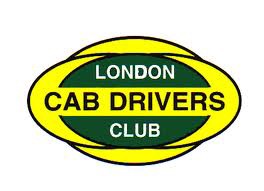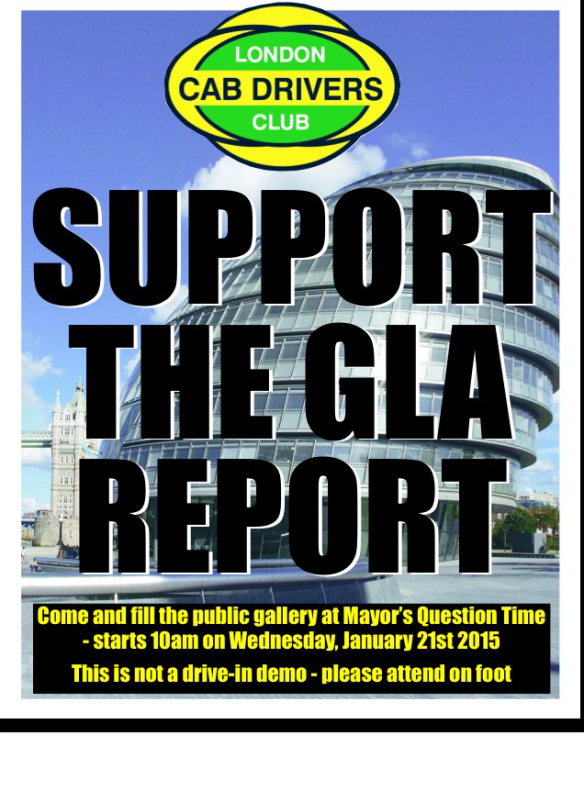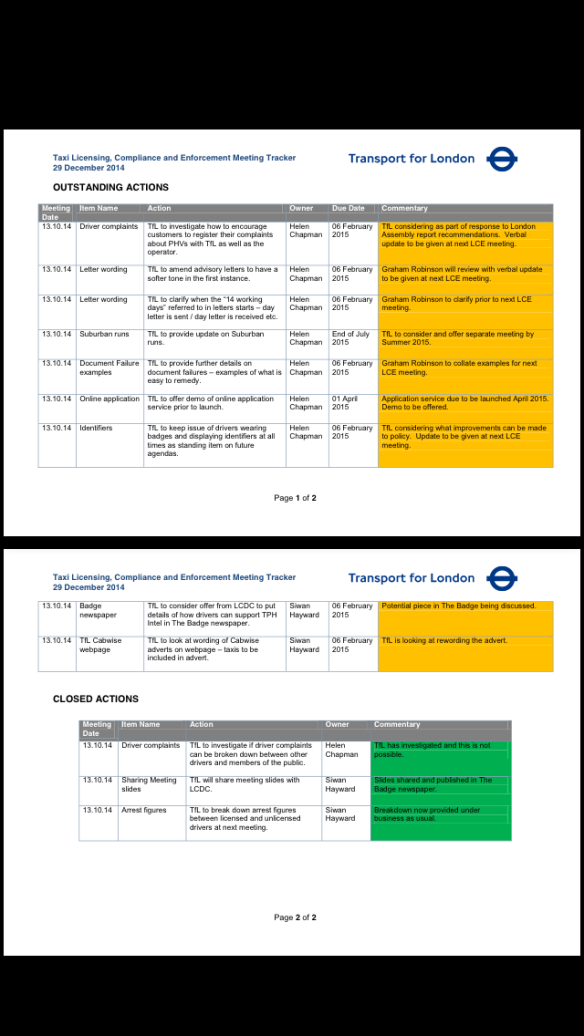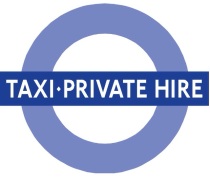Hi, were glad to inform you that we have a brand new web site now that offers you so much more than this blog can. It will keep you up to date with all trade stories and allow you to join up online. All member’s will also be available to take advantage of the offers from the greenbadge promotions website that we have joined up with. You can find the new site by clicking on the link here http://www.lcdc.cab
Author Archives: LCDC
TPH Notice 01/15 – Private Hire Vehicles – Have Your Say.
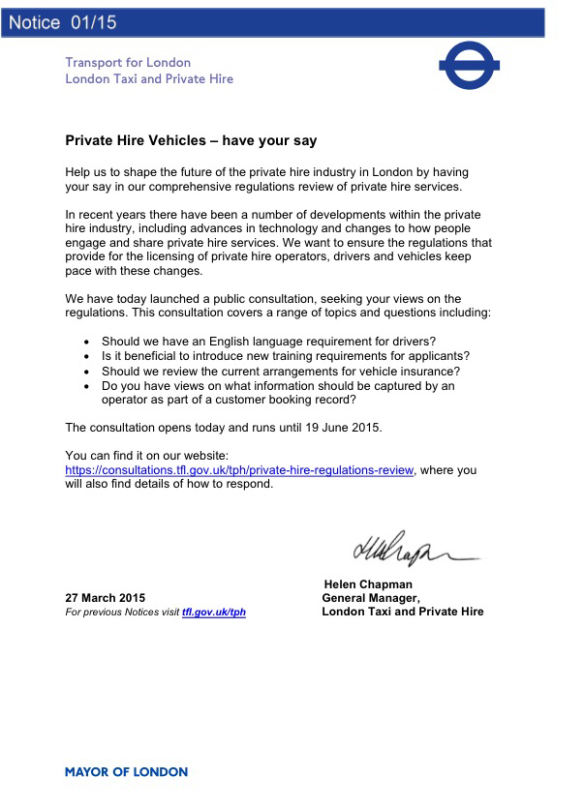
Transport for London submits application to High Court for declaration on taximeters

Transport for London (TfL), which regulates and licenses the taxi and private hire trades in the Capital in the interests of passengers, submitted its application on Wednesday 25 March to the High Court for a declaration on taximeters.
This follows confirmation that the Licensed Taxi Drivers Association (LTDA) has invited the Magistrates’ Court to withdraw their summonses for breach of the private hire taximeter prohibition.
The application to the High Court has been served on Uber and the main trade bodies – the LTDA and the Licensed Private Hire Car Association – who will be entitled to make representationsin response to the application.
TfL is seeking a High Court declaration on whether smart phones, which use GPS technology to measure the time and distance of a journey and then receive information about fares, comply with the current law on ‘taximeters’, which can only be used in London by taxis.
The rapid pace at which smart phone based technology has developed in recent years has led to a need for clarity about what is required in order for apps to comply with the regulatory framework in London, to ensure there is a level playing field for all operators.
TfL set out its view that on balance smart phones used by private hire drivers do not constitute the equipping of a vehicle with a ‘taximeter’. However, because the legislation in this area is unclear and able to be interpreted in various ways, TfL has applied to the High Court to give a binding determination on this issue.
Leon Daniels, TfL’s Managing Director of Surface Transport, said: “We are now a step closer to securing a High Court declaration on the issue of taximeters and hope that London’s taxi and private hire drivers and operators will work with us.
“We welcome developments that make life easier for passengers. As in many other areas of transport and retail services, apps can offer passengers the potential of better and more convenient services, but their use must be legal and on the issue of taximeters the law is unclear. A binding High Court declaration will bring clarity on this issue for all parties.”
TfL anticipates that the hearing will be held this summer.
TfL confirms intention to lodge High Court application on taximeter issue
A Transport for London spokesperson said: “We have made clear previously that it is our view that smart phones used by private hire drivers do not constitute the equipping of a vehicle with a taxi meter where they act as GPS tracking devices to measure journey distances and relay information so that fares can be calculated remotely from the vehicle.
“However, we acknowledge that this issue is not straightforward and is open to an alternative interpretation. The most appropriate way forward is to invite the High Court to issue a declaration on this issue.
“Whilst there were ongoing criminal proceedings in the Magistrates’ Court, we could not proceed with an application to the High Court. TheMagistrates’ Court has been invited to withdraw those proceedings and TfL will now proceed with its application to the High Court.”
Letter to LTDA and UNITE RE: ULEZ meeting on 19/1/2015
The LCDC did not attend the trade ULEZ meeting at the LTDA on Monday.
This has caused many rumours to circulate within the Trade.
This is the email which was sent out to both the LTDA & Unite.
21st January 2015
ULEZ, age limits and zero emission capable taxis
Dear Jim and Steve
We have reviewed the notes and comments that have been issued from Monday’s meeting between yourselves and some of the representatives from the other organisations and we would like to clarify our own position on these matters.
Age limits
Naturally, and because the members of the committee of the LCDC are all working cab drivers, we fully support the need to retain the 15‐year age limit.
As you know from our own response document submitted to TfL we also concur that the economic hardship that a 10‐year age limit would impose on the taxi trade would be impossible to bear.
Frankly the subsidies available from TfL, OLEV or government would in no way come near to covering the cost of £200 million to scrap all over 10 year old cabs. The most has been mentioned in all the ULEZ meetings we have attended has been £40 million.
Fundamentally we believe that the only reason TfL proposed a 10‐year age limit is because they believe there will be zero emission capable cabs in 2018. If they did not believe there would be zero emission capable cabs then they would find it much harder to justify reducing the age limit to 10 years.
It is this link between age limits and zero emission capable taxis which we feel is most critical. Break the link and you break the argument for a 10‐year limit.
Zero emission capable taxis
We at the LCDC do not believe there will be zero emission capable taxis, properly tested and available as working taxis by 2018. You can see our detailed rationale for this in our response document. We also thought that the rest of the taxi trade organisations subscribed to that view as well.
This point was voiced most strongly by Mike Hedges, Peter Bond and Steve McNamara at the ULEZ meeting at 55 Broadway on 10th December 2014. And then again, in front of the GLA Environment Committee on 4th December, Steve also said that he believed that zero emission capable taxis wouldn’t happen when he said “The reality is that we’re probably going to be in a situation on 1st January 2018 when there isn’t a vehicle available.” It is also forcefully argued by Barry Hooper in his last article in TAXI on 9th December and we have quoted his comments extensively in our response to TfL. If we are wrong and zero emission capable taxis are available as proven taxis by 2018 then we are wrong.
But what we believe is that the Mayor should not make policy on a few vehicle manufacturers’ promises and a few prototype vehicles. The manufacturers involved have either no track record or a poor track record of delivering what they say when they say. We’ve already seen one of them, Nissan, drop out and yet they had been promising so much for years.
What the taxi trade should be saying to the Mayor is that he should only bring in this policy of zero emission capable taxis when the manufacturers have demonstrated that they are really capable of doing so. This should be measured by the fact that at least 2 manufacturers should be capable of producing 1,000 taxis each when the policy is approved.
It is also important that these zero emission taxis are really capable of achieving properly the agreed set targets. For example, we have issues with TfL proposing to set a measurement of CO2 emissions (the 50g/km) when it is not the CO2 but the NOx that causes the real respiratory problems for Londoners.
We also firmly subscribe to the view that there should be a separate, independently tested, taxi drive cycle which is used as the measurement for emissions and not the New European Drive Cycle.
This NEDC is still nowhere near reflective of real taxi driving conditions. That’s why Kings College has been able to produce research which could show that older cabs produce fewer NOx emissions.
We note that it was considered to be urgent to understand what the OLEV subsidies will be on the zero emission capable taxis.
This is difficult to justify on two counts. First, OLEV stated at the ULEZ meeting on 10th December that any extra grants would not be available until 2020. Second, even if there was a £10,000 grant, that would still not be relevant until we knew the price of the taxi. What if the price was £70,000?
Infrastructure
The lack of availability of super‐fast charging points was a good point made by Jim. What’s the point in having over 22,000 taxis chasing the 150 charging points which Elliot Treharne said would be made available for taxi drivers (Elliot Treharne, GLA Environment Committee on 4/12/14) – that’s just nowhere near enough.
Another significant technical flaw in the argument to introduce zero emission capable taxis is that there is no way that you can determine where a vehicle will undertake its 30‐ miles zero emissions on battery only. You might have a taxi using only its internal combustion engine in the ULEZ, causing more emissions, because its battery power has been exhausted. It has even been admitted by Matthew Pencharz at the Environment Committee meeting that this would require geo‐fencing, something which TfL are not capable of implementing.
Parity with private hire or others
Be careful about what you ask for. Asking for parity plays into the hands of TfL asking for a 10‐year age limit. Let me explain.
On the face of it, it seems sensible that private hire should have parity with taxis for newly licensed vehicles. By this you refer to the fact that although TfL require newly licensed PHV’s to be zero emission capable from January 2018, second hand vehicles (older than 18 months old) to be licensed as PHV’s need only be to Euro 6 standard. You say that all new or second hand PHV’s should be zero emission capable.
I have heard the phrase “ZEC’s for all!” However, what is ignored is the reason why TfL made this proposal: they say it’s because there is a far higher turnover of vehicles in the PHV sector (see TfL Consultation ‐ Supplementary Information, page 19), over 14,500 newly licensed per year.
The average age of PHV’s is only 5 years, which has been reduced by the current policy of a 10 year age limit. Therefore, by arguing for parity with PHV’s you end up strengthening the argument for taxis also having a 10‐year age limit.
By contrast the LCDC argue that taxis should have parity with the rest of the commercial vehicle industry in London.
In our response document (Point 16) we highlight the fact that coaches, HGV’s and LCV’s need only be Euro 6 to enter the ULEZ. Yet HGV’s, coaches and LCV’s contribute 34% to ULEZ emissions whereas taxis and PHV’s contribute only 22%. We believe that taxis should be just the same as commercial vehicles – i.e. Euro 6. The new Euro 6 vehicles have 84% lower emissions that Euro 5’s.
What TfL should be doing is encouraging taxis, PHV’s and commercial vehicles to get into Euro 6’s as soon as possible. That will reducing emissions faster than delaying implementing and unachievable policy of zero emissions for another 5 years.
Kind regards
Darryl Cox Secretary, the LCDC
21-01-15 @ 10AM Support The GLA Report.
After the recent GLA report that had vindicated the cab trades actions over the past years and has highlighted TFL woeful management of our Industry, we have decided to show our support for the GLA by attending the first Q&A meeting with the Mayor.
This is not a drive in, nor a demonstration, but a lobby, on foot to attend the public gallery and have a presence outside City Hall.
Make no mistake TFL would love to kick the report into the long grass, we must keep the GLA recommendations in the fore front of our actions.
London Bridge Station Modernisation Update
TfL advice to customers during major Network Rail modernisation work at London Bridge mainline station
· TfL reminds customers that several already busy London Underground and London Overground stations are likely to be busier than usual during the changes to National Rail services that start on Monday 12 January
· Extra station and bus staff and extra bus services being deployed to assist customers
· Customers who have flexibility in their journey times advised to avoid peak times at Canada Water station if they can
· Passengers affected by Thameslink Programme should make sure that they have the latest ticket to travel on the TfL network
Transport for London (TfL) is reminding customers that long term National Rail service changes being undertaken by Network Rail at London Bridge mainline station are likely to result in busier than usual services, on certain parts of the transport network, as some customers who usually travel directly to London Bridge by rail use TfL services instead.
From 12 January 2015 until August 2016, major Network Rail modernisation work will take place at London Bridge station and Southeastern rail services to and from Charing Cross will not call at London Bridge. Southeastern services from New Cross, St. Johns, Deptford, Greenwich, Maze Hill and Westcombe Park stations will no longer operate to and from London Charing Cross or Waterloo East, and will instead operate to and from London Cannon Street. No Bedford to Brighton Thameslink trains will call at London Bridge station until January 2018.
London Bridge Underground station will operate as normal throughout all the work. The Jubilee line at London Bridge, and other stations including Blackfriars, Cannon Street, Charing Cross, Embankment, Elephant and Castle, Southwark, Victoria and Waterloo are likely to be busier than usual due to diverted National Rail passengers. Parts of the London Overground network, especially Canada Water, Brockley and New Cross, the DLR and some bus services are also likely to be busier. Customers who have flexibility in their journey times are advised to avoid peak times at Canada Water if they can.
Extra station and bus staff are being deployed to offer additional customers assistance, and dozens of extra services on the bus network are being provided, including:
Ten additional double deck buses on Route 21 between London Bridge to Lewisham via New Cross during the evening peak;
Ten additional buses on Route 47 between London Bridge (Duke Street Hill) and Lewisham via Bermondsey;
Ten additional Route 381 buses acting as a shuttle between London Bridge and Waterloo stations during the morning and evening peaks.
Cannon Street mainline and Tube station will open seven days a week with extended hours to accommodate additional rail passengers.
Network Rail passengers who have a London Terminals season ticket may need to update their ticket to ensure it is valid for travel on the TfL network. For more information on updating tickets customers are being advised to speak to staff at any National Rail ticket office, or visit: http://www.ThameslinkProgramme.co.uk/key-dates-and-service-changes/january-2015/
Mike Brown MVO, Managing Director of London Underground, said: “During Network Rail’s modernisation work at London Bridge rail station, several London Underground and London Overground stations are likely to be busier than usual. We are accepting tickets at key stations from passengers whose journeys to London Bridge are affected, and deploying extra staff to assist customers and putting on dozens of extra bus services out of London Bridge and Waterloo. We will continue to keep all our customers informed with regular travel information via our staff, website and social media. As always, if you have the flexibility to do so, please think about timing your journey outside the busiest times.”
London Cab Drivers Club response to TfL Ultra Low Emission Zone Consultation
London Cab Drivers Club response to TfL Ultra Low Emission Zone consultation issued 27th October 2014
Introduction
1. The London Cab Drivers Club (LCDC) is one of the main taxi trade organisations in London, actively involved in committees and liaison meetings with TfL at all levels. We have participated in the recent GLA investigation into Taxi and Private Hire services in London and in the TfL consultation meetings on the Cycle Super Highway. We have also attended all the ULEZ consultation meetings organised by TfL, engaged with stakeholders including manufacturers, road users, influence groups and trade organisations. Our Chairman sits on the Mayor’s “Cabbie Cabinet” which meets quarterly to discuss strategic issues. The main strength of the LCDC is that all of its committee members are active and working London taxi drivers. This means our organisation is uniquely close to the key issues and attitudes of London taxi drivers.
2. The LCDC welcomes the opportunity to formally respond to the consultation and proposals for the introduction of the ULEZ in 2020 and the licensing of only zero emissions capable new taxis and private hire vehicles from January 2018. We also totally support the Mayor’s aims of reducing pollution and emissions in London, making our city a safer and more pleasant place to live and work in. In this response we will putting forward a number of positive recommendations to reduce taxi emissions in London.
3. This response concentrates on the effects of the TfL proposals on London’s taxi industry. The standard proposed by TfL for zero emissions capable taxis has been defined as: having an average CO2 emission of 50g/km; a capability of 30 miles continuous on battery power alone; and with a supporting internal combustion engine using petrol only; and the introduction of a 10-year age limit from September 2020. The 50g/km target compares with the EU agreed target of 95g/km by 2020.
4. We agree with Matthew Pencharz (Senior Policy Advisor to the Mayor) when he said that the proposed ULEZ scheme needs to be “fair, proportionate, reasonable andaffordable” (GLA Environment Committee 4th December 2014). Therefore any scheme to reduce emissions for London’s taxis should be: fair and reasonable because it should not disadvantage taxis compared to other businesses in London; it should be affordable for the taxi industry so that it does not put an unreasonable or intolerable economic burden on the taxi trade; and above all it should be proportionate and achievable because it adopts a technology standard that is capable of being supplied by manufacturers offering taxi drivers a choice of purpose built taxis.
5. Through the active involvement and discussions with all the stakeholders involved in the ULEZ meetings we have come to the conclusion that the outcome of the current proposals, if implemented, will be quite the opposite of the intention of the Mayor’s Senior Policy Advisor. The LCDC, along with the other taxi trade organisations as well as Private Hire bodies view the proposals as being: “unfair, unreasonable, disproportionate and certainly unaffordable.”
6. The LCDC makes a series of proposals to the Mayor to reduce emissions in London. These can be seen in our ‘Recommendations’ section. Instead of outlawing older cabs the Mayor should immediately incentivise the uptake of new Euro 6 standard taxis in London. These vehicles, with much lower polluting NOx emissions, promise to significantly reduce taxi pollution. Moreover, it is only sensible to introduce regulations which include hybrid or electric vehicles when those taxis are actually on the market. The Mayor’s policy should not be made on other people’s promises.
Unaffordable
7. London’s taxis already have to meet some of the strictest standards in the world: a combination of the 25-foot turning circle requirement and the need to meet defined accessibility standards result in only two vehicles meeting the criteria and at a high average price of circa £40,000. This is more than double the cost of a typical saloon vehicle which is used by private hire drivers in London. The way in which the purpose built taxi driver has been able to make his vehicle economically justifiable has been through the ability to depreciate his taxi over a longer period of time. As a result London taxis are well known for their durability and high quality standards. Historically vehicles have lasted for at least 15 years, although this was capped from 2012 when a 15-year age limit was introduced.
8. However, the proposal to introduce a 10-year age limit will have a significant impact on the viability of the London taxi. In the current market a typical 10-year old taxi can have a re-sale value of £10,000. If the owner/driver is required to scrap or dispose of his taxi after 10-years then the scrappage cost for the total London fleet of 22,500 taxis would be at least £200 million. This is considerably in excess of the £40 million support being considered. At the GLA Environment Committee meeting on 4th December 2014 it was stated by Elliot Treharne of the GLA that the £40 million would be made available to the 7,000 drivers whose cabs would have reached 10 years old in 2020. This works out at £5,700 per taxi, or half the actual depreciation cost to be borne by the taxi owner. Moreover, it is hardly fair or reasonable NOT to also support taxi owners whose taxis become 10-years old in 2021-2024, 10 years after the 10-year age limit was first announced. Surely it cannot be fair to exclude taxi owners who bought taxis in 2013 when they were not aware of the proposed 10-year limit. Furthermore the economic impact on the remaining drivers will be such that it will seriously undermine the ‘business case’ for becoming a taxi driver.
9. Savings of up to £3,000 per annum have been suggested by converting to electric hybrid vehicles (Matthew Pencharz at GLA Environment Committee on 4th December 2014). We are not aware of this calculation and would like to see these being real world savings and not just a forecast. The Osaka syndrome where taxi drivers of electric vehicles tried to conserve energy by switching off their heaters and lights demonstrates the risks of assuming savings on electric vehicles (see report in Japan Today 20/2/13). London’s taxis working in an inner city environment, using more air conditioning, heating and stop/start energy will quickly use up the battery power. Moreover plug-in charge points may well prove to be expensive due TfL’s decision to privatise London’s charging points.
10. Hybrid vehicles meeting the proposed criteria will not be widely available, if at all, by 2018 and therefore will be more expensive due to the high capital investment required by manufacturers aiming to enter the market in 2018.
11. It is estimated by TfL that approximately 30% of London’s taxis would be forced off the road in 2020 (Michelle Dix at Royal Mint Court on 25th November 2014). As the economics argument becomes more difficult to justify in the taxi driver’s own mind then there is a significant risk that there may be a substantial fall in the number of taxi drivers and taxis in London. This would jeopardise accessibility and safety on London’s streets by taking at least 7,000 taxis off the road before they could be replaced. The Mayor and TfL would do well to understand the reasons for the growing tide of protests against TfL by the taxi trade.
Disproportionate and unachievable
12. Vehicle manufacturers have been committed to support the drive towards lower emissions through investing billions in the Euro standards regime with lower emission engines, hybrid technology and light weighting of components. Both the London Taxi Company and Mercedes-Benz will be introducing Euro 6 compliant engine technology during 2015. The Euro 6 standard represents a major shift down in terms of NOx emissions, making diesel emissions equivalent to petrol engines.
13. By 2020 motor manufacturers are aiming that their new vehicles will achieve a European target of average CO2 emissions of 95g/km. Yet the TfL proposed standard of 50g/km, is nearly half that European target level and it is claimed that manufacturers will have this technology ready for January 2018.
14. Of the three manufacturers quoted by Matthew Pencharz on 4th December being capable of producing zero emission capable taxis by 2018 only one is a current manufacturer. The other two do not currently have approved production-intent taxis on the market. We understand and agree with the position that Steve McNamara of the LTDA took on this matter (see his submission to GLA Environment Committee on 4th December 2014): there is too much at risk, too much uncertainty to frame regulations based on what some vehicle designers and manufacturers may or may not be capable of achieving in 2018.
15. We also endorse the late Barry Hooper when he wrote in his last TAXI magazine article (TAXI magazine 9th December 2014. Page 10). Barry cast doubt on the effects of the zero emissions proposal for taxis and the likely outcome with the manufacturers…. “So, where are we now? Nissan is out. Mercedes long term future in the trade is uncertain, but is probably also out……….The new Metro as far as I know is not yet in production and even if it does go into production will not be available for a year or two and the price tag will be very high. That means only one thing, a return to the bad old days at M&O, or LTC as it is now known………This is all down to the Mayor. He is pinning his plan on vehicles that are simply NOT available.” The LCDC would go further: the Mayor will legislate at his peril, and ours, based on the promises made by any vehicle manufacturer. We encourage the Mayor to wait until we see the green vehicles in place before putting the taxi trade at such severe risk.
Unfair and unreasonable
16. It is unreasonable for taxi drivers that TfL has set the Euro 6 standard for coaches, vans and HGV’s, which together account for 34% of London’s emissions, but it has set the zero emissions capable standard for the taxi and private hire industry which account for a lower 22% of London emissions. The TfL reason for only applying the Euro 6 standard to coaches, vans and HGV’s is that zero emissions is not available on these forms of transport (Michelle Dix in answer to questions at ULEZ conference at Royal Mint on 25/11/14). In our view it is reasonable that the same rationale should be applied to taxis and private hire. Or, at the very least, the Mayor and TfL should not consider introducing the zero emission standard until there are vehicles in operation, meeting these standards.
17. The LCDC expects the sales of new Euro 6 taxis to fall because of the fear and uncertainty of the proposed introduction of the age limit tied to zero emission taxis. Where will this leave the manufacturers, like the London Taxi Company who claim to have invested over £10 million* in achieving the Euro 6 standard for their TX4 taxi? Without a return on the Euro 6 investment how can the main supplier hope to carry through its future investments? (* source: claim made by Dave Oriel of LTC at ULEZ meeting, TfL offices, 55 Broadway on 10th December 2014)
Euro 6 standard and the taxi duty cycle
18. The introduction of the Euro 6 standard is recognised by TfL and manufacturers as representing a major change in reducing emissions. Diesel vehicles, including taxis, which will be available from next year will considerably reduce NOx emissions to similar levels compared to petrol vehicles. Our view is that if TfL wish to have a major impact on quickly reducing emissions coming from taxis then there should be an accelerated programme of incentivising the uptake of Euro 6. The table below shows how the NOx levels of a Euro 6 diesel vehicle will be some 84% lower than the NOx levels of a Euro 3 vehicle.
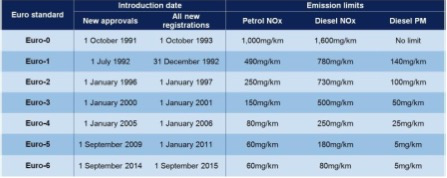
Source: SMMT see: http://www.smmt.co.uk/industry-topics/air-quality/#responsiveTabs3
19. Much has been made of the introduction of the NEDC (New European Driving Cycle) standard of testing which will be applied to new Euro 6 vehicles. This is aimed at overcoming some of the criticism of the previous testing regime because it did not reflect the real world driving. The new testing standard also includes some on road driving. However we believe that even this test is inappropriate and will not reflect the real world in London. TfL’s own road cycle for central London (ref. TfL Travel in London Report 3 fig 4.1) shows much lower speeds than the NEDC R101 test cycle, and even then a significant proportion of the area considered was outside the ULEZ. Moreover the duty cycle of London’s taxi fleet is quite different from a car or van working in London. Taxi work involves much more stopping with engine running or stop/starting (on ranks) and slow ‘trawling’ looking for work; along with acceleration and higher speeds for runs to Heathrow and Gatwick. The LCDC consulted several of its members and these drivers estimate that as much as 30% of their time is ‘dead’ mileage. Therefore it is strongly recommended that TfL understand the real taxi duty cycle and the emissions on any taxi model coming into London by developing a London taxi duty cycle. From this TfL would be able to gauge real world emissions of taxi and develop targeted standards accordingly.
Inappropriate standards
20. The distinction between petrol and diesel, where TfL intend to allow only petrol engines in new taxis from 2018, is inappropriate. Whilst we understand the arguments behind reducing the number of polluting diesels on the road, it is also recognised that the new Euro 6 diesels provide reduced NOx emissions very similar to equivalent to petrol vehicles. Also, diesel engines are inherently more efficient and produce better CO2 figures and economy per vehicle than petrol engines. See SMMT New Car CO2 Report 2014 at http://www.smmt.co.uk/wp-content/uploads/sites/2/SMMT-New-Car-CO2-Report- 2014-final1.pdf
21. 30 miles zero emission capability is specified but the type of hybrid vehicle also needs to be appropriate. Thus, parallel hybrids are more appropriate for inter-city or suburban work, with longer journeys: parallel hybrids are low range EV’s with small batteries. Whereas series hybrids can deliver longer continuous zero emissions but need larger batteries for inner city work. The disadvantage with series hybrids is that the larger batteries require more re-charging to deliver the performance target of 30 miles zero emissions, and may not be achievable when undergoing the normal taxi duty cycle.
22. The aim of achieving 50g/km CO2 emission is incompatible with the requirement to have 30 miles zero emission range. This will require vehicles to have to have substantial and heavy battery packs which will increase weight and therefore also increase the non- electric fuel consumption and CO2 emissions.
23. There is no certainty at all where geographically the 30 miles of battery powered zero emissions will take place. What if the zero emissions occur completely outside the ULEZ zone, when the taxi driver is travelling into or out of work? Unless a most technologically complicated system of geo-fencing is employed then there can be no certainty that any of the zero emissions will be in the ULEZ.
24. The NEDC is short, it allows high use of plug-in hybrid’s battery capacity. Under typical taxi mileage of 70-100 miles per day 50g/km will not be achieved. If battery use is exhausted in ULEZ then the remaining mileage will be significantly higher than 50g/km.
Summary and recommendations
25. The 10-year age limit and new more expensive taxis will be extremely damaging to the taxi trade. Even with the proposed TfL incentives many drivers may leave the trade and new drivers may opt to go to private hire. This will by definition reduce the provision of safe, accessible transport for London’s population.
26. Recommendation 1. We strongly recommend that the Mayor waits until the technology is in place and working before introducing the TfL proposals for zero emission taxis from 2018. There is a significant level of risk that no manufacturer will be able to meet the proposed zero emission requirements and at a true London taxi duty cycle. To frame policy before the technology is available and proven is not responsible. The Mayor should declare his intention to introduce the 50g/km target but only when a minimum of 2 vehicle manufacturers can demonstrate they can produce taxis to at least a volume of 1,000 each per annum. If a zero emission target is introduced then it also must be capable of being programmed so it works in the ULEZ zone.
27. Recommendation 2. TfL should encourage sales of Euro 6 diesel engine taxis as the fastest most practical way of reducing taxi emissions in London. This could be done by providing some level of purchase incentive on Euro 6 taxis.
28. Recommendation 3. The Mayor should require TfL to introduce a standard taxi duty cycle which sets the emissions testing measurement for any taxi vehicle which is introduced into London, to hit the 50g/km target or whatever target is agreed as achievable.
Taxi Licensing, Compliance and Enforcement Meeting Tracker
“The LCDC Chairman made a controversial decision last month to attend the Compliance meeting after the LTDA & Unite decided to boycott that part of the day. Someone had to explain to TfL ‘why?’ and challenge the current regime over their thinking. Here are the actions that LTPH compliance have said they will look into.
We will be following up with this and events including ‘Shine’, Old Billingsgate, RD2 and Battersea Park.
Suburban Taxi Driver Licensing Provisional outcome of suburban review
Click the link below to read the Suburban review
Suburban Taxi Driver Licensing Provisional outcome of suburban review

